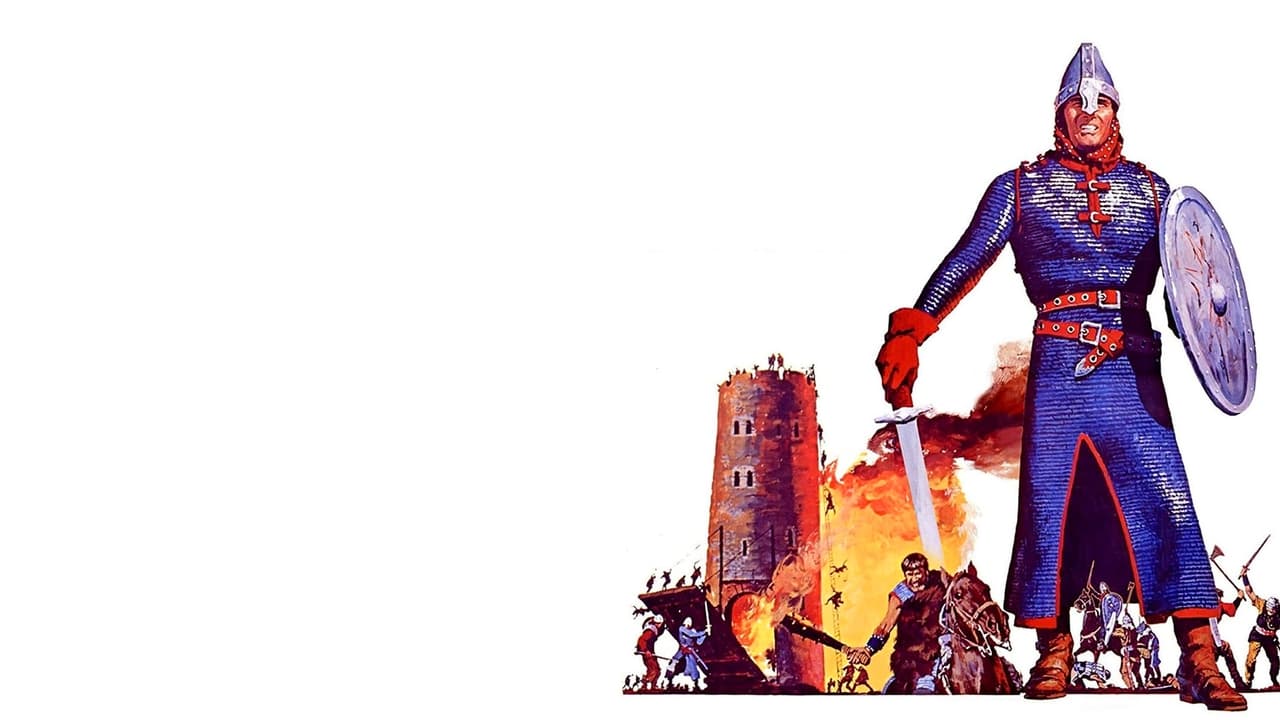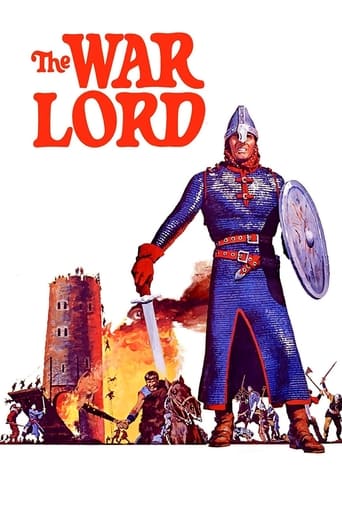

Playing the title role of The War Lord is Charlton Heston in a tale set in medieval Normandy in the 11th century. It's a fine epic story even though Heston's character while noble for his time is also a bit thick.Heston is an honored and respected knight who has been given charge of a coastal area to defend it from the invading Frisians. He's got a company of men at arms including brother Guy Stockwell and family retainer Richard Boone. After one Frisian raid, the little Frisian prince played by Johnny Jenson is left behind and caught and naturally his dad Henry Wilcoxon wants him back. The natives themselves are a problem. The local priest Maurice Evans has been trying to win them away from their Druid religion. But it's a tough battle. Evans plays an interesting part and in keeping with missionary tradition. Though the function of a missionary is to win native people away from whatever beliefs they hold at the same time missionaries have saved native populations from the more depraved aspects of Christian civilization. Evans in his century is a whole lot like a David Livingstone.Guy Stockwell is the Mordred of the story. He's insanely jealous of the favor his brother is looked upon. He also is guilty of some of the clearest thinking in the film. That clear thinking is concerned with Rosemary Forsyth, a beautiful peasant girl that gets Heston's hormones charged. He reaches back to the Druid religion of the lord having first crack at a bride on her wedding night. But then refuses to give her up. They both fall in love, but the peasant kid she's married to James Farentino is also son of the village headman Niall McGinniss.It all involves the Druids teaming up with the Frisians the people who had been their sworn enemies with Heston having both Farentino's bride and the Frisian prince held at his tower. A good 40% of the film deals with the siege of that tower.The War Lord is a grand medieval pageant with Charlton Heston at his most heroic even though the man is absolutely dense to the consequences of what he's done. He's also a bit ahead of his times, but sadly alone there and it's never good to be too far ahead.Jerome Moross wrote a beautiful score for The War Lord that really captures the mood of those medieval times. Franklin Schaffner got a good ensemble performance from his cast. Pay particular attention to Guy Stockwell and to Richard Boone as well.
... View MoreLet's see, our "hero" is a rapist...a fratricide...AND a traitor, to the Duke who elevated him...and all for the sake of getting his rocks off with the only available hot box in the boondocks. Please don't tell me he did it for LOVE. That chick does have a smokin' bod, but she also has the personality of a sack of rocks...if a sack of rocks could quiver like a timid girl and pout. Ugh.As for the cinematic qualities, it is hard to imagine anyone too young to have been to a drive-in movie sitting through this. I suspect most of the viewers who rate this film highly are at least 50, and saw it when they were boys. I'm glad it reminds them of their carefree barefoot days playing sword-fight in the back yard, but don't hold your breath waiting for the remake.One interesting footnote: I bet this is the movie dwarf who inspired that dwarf in Game of Thrones. He's a dead ringer! And George R.R.Martin is old enough to have seen The War Lord at the local drive-in when he was a boy.
... View MoreDrama about Heston as a medieval knight who is given some remote northwestern coastal village as his fiefdom. The Duke tells him to clean up the place and make sure the stupid villagers are Christians and no longer Druids. Yes, when Feudalism was in flower.The most impressive thing about the film is the production design. Everything LOOKS authentically ten-sixtyish. The village is a pig stye and so is the "castle," which, as Heston observes, consists of marshes and a lone tower. The tower, reachable only by a small drawbridge, is about five stories high. It's the sloppiest castle you've ever imagined. When Heston and the dozen or so men in his retinue first enter it, bodies are strewn about and furniture overturned. Heston orders, "Clean this up," or words to that effect. The men do, but afterward they continue to throw their leftovers on the floors. The furniture itself makes St. Vincent De Paul look like Nieman-Marcus.My God, what uncomfortable armor -- and how ugly, those full-length coats of chain mail. And those soup-bowl haircuts. Only Heston, he of the aquiline beak and jutting chin could survive such a haircut. The men, however, are closely shaved by the studio's barber. We want them realistic but not offensive. Wardrobe has made the villagers drab, except for the girl Heston falls for, in the biggest mistake of his life, who has a loosely draped gown with a cunning décolletage and a slit up the side like Shanghai Lil's.That girl is Rosemary Forsythe, which brings us to the performers. Plump-lipped and, even PG, Rosemary Forsythe is attractive enough but can't act very well. That's not too much of an irritant because she hasn't that many lines. She's quite tall, almost as tall as Heston. Put her together with Uma Thurman and Mariel Hemingway and you've got the beginnings of a girl's basketball team.Heston is at his stalwart best, but he is as dumb as one of the Druid's carved trees. If he can make a mistake, he takes advantage of the opportunity. He develops a case of intense lust for Forsythe after glimpsing her in the river and exchanging a dozen lines with her. He frets. He utters hoarse, goaty cries as he destroys tables in an excess of heat. Why he simply doesn't relieve himself solo is a puzzle the writers never solve. He hardly knows the girl and, when you get right down to it, there are farm animals all over the place. But he plays the character as written, and does it well.Boone is the self-contained and ever-loyal bodyguard. Guy Stockwell is the jealous younger brother who finally precipitates a fatal quarrel just when victory seems to have been achieved. Stockwell is unlikable from the beginning. Every utterance is accompanied by a sweaty sneer. He's cynical, ruthless, and greedy. The knife fight between him and Heston ends in a cliché. The two are struggling over a knife and are pulled together with a thump, face to face. The action stops and we know one of them has a knife in his belly. Stockwell's twitching face lifts into a smile. But you're not fooled for a moment.The writers include John Collier, who is skilled in his craft, but the drama here is pretty murky. There are a couple of oppositions. First, the Frisian Islanders who raid the village fight Heston and his men. It's hard to know who to root for, although we are on Heston's side because we've gotten to KNOW these people and Heston is, after all, Heston. But the lingo of the Frisians, who live on islands just off the Netherlands, was the closest to English of any language in Europe and, I think, it still is. Some sentences in Frisian and English are almost identical. There's one about wanting a piece of green cheese that IS identical. Think about that for a minute.Also, this "droit de seigneur" business. It never existed. It was one of those legends from, I think, a Roman traveler who attributed it to barbarians in the Middle East or some other alien place. And the dialog: "You can go to hell." "I've been there."The musical score, if you listen to it with any degree of diligence, is generic. The love theme is derived from a folk tune and is given a syrupy arrangement. The action music is lifted in whole or in parts from other epic stories of the period, like "Taras Bulba." But I don't want to go on carping about these things because they're all made up for by wardrobe, production design, and some of the performances. I exclude Maurice Evans, along with Rosemary Forsythe, from the list of good performances. He has an old-fashioned, stagy Shakespearian style. His voice quivers like John Gielgud's, but Gielgud seems to know about it and Evans never really did. Lawrence Olivier's Shakespeare was always delivered in a more naturalistic and convincing style.
... View MoreA long serving Knight named Chrysagon (Charlton Heston) is sent by his Duke to safeguard a dismal coastal outpost of swamps and fens from a lone tower. Here he finds himself troubled by the Frisian raiders, his non-Christian nature worshiping subjects and his own growing desire for a peasant girl named Bronwyn (Rosemary Forsyth).Heston has some good scenes, but his character's seemingly irrational behavior and extreme mood swings seem somewhat forced and artificial. More impressive in their portrayals are both Maurice Evans as the local priest and Guy Stockwell as Draco, Chrysagon's sly younger brother. Rounding out the cast we have Richard Boone as Bors, Chrysagon's loyal right hand man. While the part may not be perfectly suited to Boone his imposing physical presence is quite effective in this role.The film has some reasonably good action sequences (at least for the era in which it was made), some intrigue, some romance and considerable drama, but the problem seems to be that the film makers couldn't decide what kind of story they were trying to tell. In particular the romantic aspect of the film is definitely undersold. While Bronwyn is obviously smitten by the Chrysagon, other than physical attraction we don't really know why she is drawn to him, perhaps because she is given so few lines of dialog. Also given very limited time is the local mysticism and how it balances with the priests Christianity.Director Franklin J. Shaffner (Patton) while not succeeding here would reunite four years later with both Charlton Heston and Maurice Evans for a much more successful film Planet of the Apes.While not as realistic as todays films, this movie took a big step in depicting the feudal lifestyle in a more gritty and realistic fashion. This included the beliefs and attitudes of both the peasants and the lords.The first time Heston appears on screen with his pageboy haircut it's somewhat difficult not to laugh out loud.
... View More